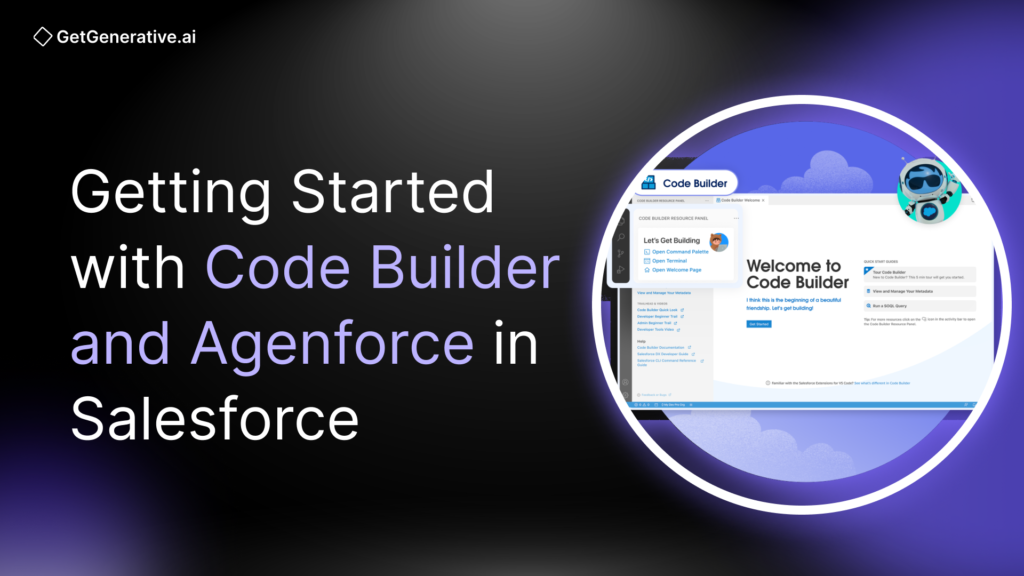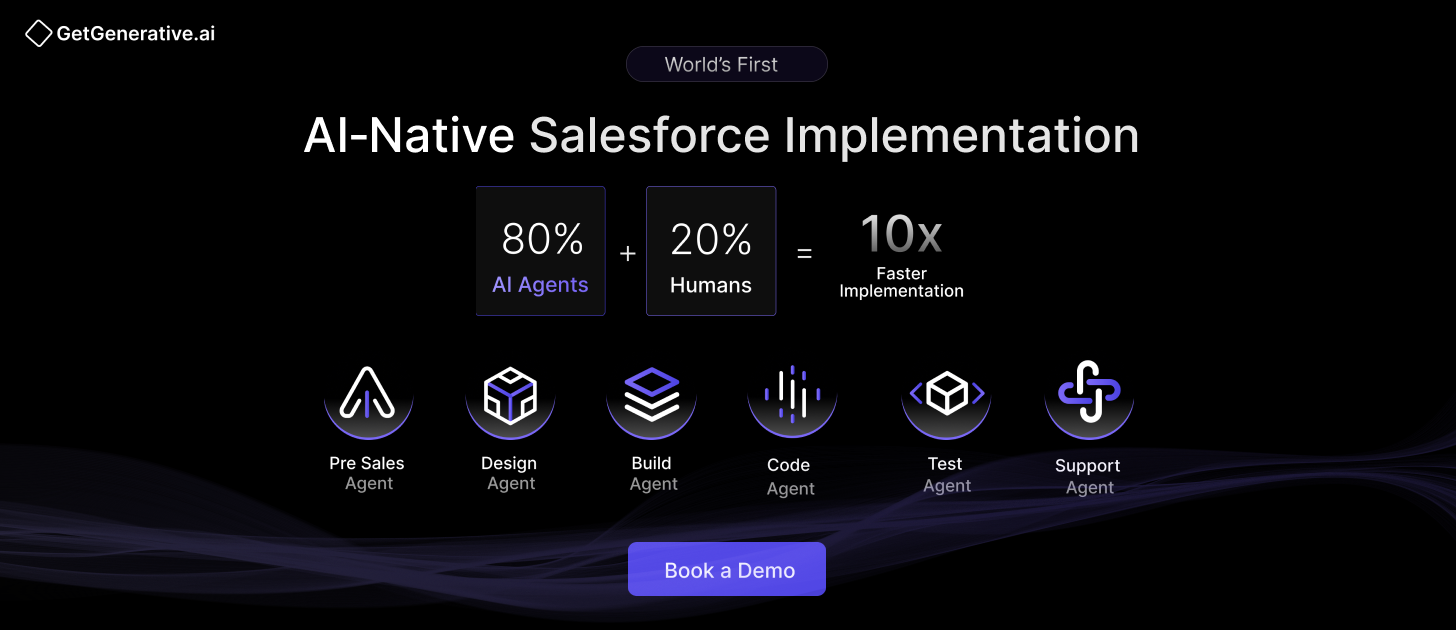Getting Started with Code Builder and Agenforce in Salesforce
Modern Salesforce development is undergoing a profound transformation. As organizations embrace AI, cloud-native tooling, and DevOps, developers and IT leaders alike are under pressure to deliver faster, with greater accuracy, and at scale.
According to Salesforce research, organizations using top-tier development tools report 65% higher innovation and 47% greater developer satisfaction and retention1.
In response to this shift, Salesforce has introduced two groundbreaking tools:
- Salesforce Code Builder – a browser-based, full-featured IDE built on Visual Studio Code, designed to streamline development with zero local setup.
- Agentforce – Salesforce’s AI agent-building platform (formerly Einstein Copilot), enabling developers to build and manage intelligent, autonomous agents that execute tasks and generate code.
Together, these platforms redefine how development teams build, test, and deploy on Salesforce.
This blog offers a comprehensive guide to getting started with Code Builder and Agentforce, exploring their capabilities, technical setup, and strategic advantages for enterprise teams. Let’s get started!
Understanding Salesforce Code Builder
What Is Code Builder?
Salesforce Code Builder is a cloud-based integrated development environment (IDE) that brings the power of Salesforce Extensions for VS Code directly into your browser. With no local installations or setup needed, developers can launch, configure, and start building Salesforce apps in minutes.
It includes:
- Salesforce CLI pre-installed
- Full Apex, LWC, SOQL support
- GitHub integration
- Built-in analyzers, linters, and debugging tools
This makes it an ideal solution for organizations prioritizing rapid onboarding, security compliance, and distributed team collaboration.
Key Features of Code Builder
Feature | Description |
Instant Setup | Launch a fully configured Salesforce DX environment from your browser – no downloads or installs. |
Apex, LWC & SOQL Support | Code Builder supports all Salesforce languages: Apex, Visualforce, SOQL, Lightning Web Components, and Aura. |
Integrated CLI & Git | Out-of-the-box support for Salesforce CLI and GitHub streamlines deployment and collaboration. |
Einstein for Developers | Leverage Salesforce’s generative AI (in beta) to generate or refactor code from natural language prompts. |
VS Code Marketplace Access | Extend your IDE using the Open VSX marketplace – add CI/CD, testing, syntax tools, and more. |
Org-Level Security | Runs in Salesforce’s secure cloud infrastructure and adheres to enterprise governance policies. |
How Code Builder Accelerates Development
Code Builder is designed to eliminate the time and complexity involved in setting up local environments. With pre-installed tools, automatic configuration, and persistent cloud containers, teams avoid “environment drift” and focus entirely on building features.
- Reduced Onboarding Time: New developers can start contributing immediately. No setup tutorials or dependency issues.
- Consistent Dev Experience: All team members share identical tools, versions, and extensions.
- Secure by Default: Cloud-hosted containers enforce org-level controls, avoiding risky local storage or code access.
These capabilities are particularly impactful in regulated industries like healthcare, banking, and the public sector, where compliance and tooling consistency are paramount.
How to Get Started with Code Builder
Here’s a step-by-step guide to launching your first Code Builder environment:
1. Enable Code Builder in Your Salesforce Org
- Go to Setup → Installed Packages
- Install the Code Builder managed package
- Available in Professional Edition (with API access), Enterprise, and Unlimited Editions
2. Launch a Dev Environment
- Navigate to Setup → Code Builder
- Connect to a Dev Hub and spin up a new environment
- Your browser will open the full IDE pre-loaded with your Salesforce DX project
3. Authenticate and Connect to Orgs
- Authorize your Scratch Org, Sandbox, or Production environment
- Use the built-in terminal to execute SFDX commands (sfdx force:auth:web:login, etc.)
4. Customize the Dev Environment
- Create a .devcontainer.json file to add additional libraries or tools (e.g., Node.js, Prettier, Jest)
- Share configurations across teams to maintain consistency
5. Start Building
- Begin writing Apex, Lightning Web Components, SOQL queries, or test classes
- Use the SOQL Builder to visually query Salesforce data
- Integrate Git for version control and team collaboration
Where Code Builder Fits in the Modern DevOps Lifecycle
Salesforce Code Builder is ideal for:
- Agile Sprints: Developers spin up feature-specific orgs and environments instantly
- Remote Collaboration: Distributed teams avoid local setup issues or version mismatches
- Continuous Integration/Deployment: Use GitHub or Bitbucket pipelines with sfdx CLI tools directly from the IDE
- Onboarding & Contracting: Quickly equip new developers or external vendors with secure, compliant dev environments
Strategic Advantages of Code Builder
Benefit | Impact |
Developer Efficiency | Start coding in minutes, not days. Reduce non-coding overhead. |
Compliance-Ready | Cloud-based IDE ensures no data leaves approved environments. |
Governance | Centralized control over tools, extensions, and access. |
Talent Enablement | Lower barriers for junior devs or new hires. Align everyone on the same tooling. |
Introduction: From Code to Intelligence — The Rise of AI Agents
While Code Builder revolutionizes how developers build on Salesforce, Agentforce reimagines who is doing the building.
Agentforce, Salesforce’s AI agent platform (formerly part of Einstein Copilot), lets teams create and deploy autonomous agents that understand natural language, take action using Salesforce data, and even generate code inside your IDE. For developers, it’s more than a smart assistant — it’s an AI-powered colleague.
With Agentforce, you can:
- Build custom AI agents (sales, service, support)
- Auto-generate Apex and Lightning Web Component code
- Accelerate test case development
- Simulate and preview agent behavior
- Use YAML-based agent specs aligned with GitOps workflows
What Is Agentforce? And Why Should Developers Care?
Agentforce is Salesforce’s next-gen framework for building AI-powered, task-specific agents using enterprise data. These agents go beyond simple chatbots. They understand your business context, interact with Salesforce objects, and execute workflows via natural language.
There are two ways to build with Agentforce:
- Low-Code Agent Builder: Ideal for admins and business users — configure agents visually using prebuilt templates and guided flows.
- Agentforce for Developers: A CLI and IDE-based toolkit that lets you generate agents, code, and tests directly from VS Code or Code Builder.
Also Read – Agentforce for Developers: How to Build AI-Powered Solutions
Key Capabilities of Agentforce
Feature | Description |
Custom AI Agents | Build agents for support, sales, marketing, or internal workflows. Configure topics, instructions, and actions. |
Code Generation | Use natural language to generate Apex classes, triggers, LWC components, and test methods. |
Dev Assistant Chat | Chat with your IDE. Ask it to explain code, fix bugs, or scaffold new logic. |
Inline Completions | As you type, Agentforce suggests context-aware completions in Apex, HTML, JS, and more. |
Unit Test Generation | Auto-generate test boilerplate for new classes or components. |
YAML Agent Specs | Define agents declaratively using human-readable YAML files. |
Simulation & Preview | Preview how your agent would respond to requests directly inside VS Code or Code Builder. |
Installing Agentforce in Your Salesforce Dev Environment
To get started, follow these steps:
1. Update Salesforce CLI
sf update
2. Install the Agentforce Plugin
Run your first command (e.g. sf agent generate agent-spec) and the CLI will install the plugin automatically.
3. Install the IDE Extension
Add Agentforce for Developers to your Code Builder or VS Code environment. It’s available in:
- VS Code Marketplace
- Open VSX Registry
4. Enable Developer Telemetry
In Code Builder, ensure telemetry is enabled to activate Agentforce features. Salesforce uses this for secure model access and behavior tracking.
5. Try Sample Commands
Generate a new agent spec using:
sf agent generate agent-spec
Then simulate:
sf agent preview
Developer Workflow: Using Agentforce in Code Builder
Once installed, here’s how developers can integrate Agentforce into daily workflows:
Dev Assistant Chat
- Open the chat pane (slash command or sidebar)
- Ask:
- “Explain this Apex trigger”
- “Generate a test method for this class”
- “Refactor this loop using best practices”
Code Generation
- Use the Command Palette: Agentforce: Generate Code
- Type: “Create a REST API in Apex for inserting Contacts”
- Output: Full Apex class with proper annotations and DML
Inline Code Suggestions
- As you code, Agentforce autocompletes statements based on context
- Works in .cls, .js, .html, .css — just like IntelliSense, but smarter
Test Case Generation
- Highlight a class
- Run Agentforce: Generate Unit Test
- Agentforce scaffolds @isTest methods, mocks, and assertions
Agent Previews
- Edit your YAML agent spec
- Preview conversations in a sandboxed window
- Adjust tone, behavior, and data access in real-time
Also Read – Everything You Need to Know to Implement Salesforce Agentforce in 2025
Strategic Benefits for Engineering Teams
Outcome | Benefit |
16× Faster AI Agent Delivery | Use templates and YAML specs to stand up working AI agents in days |
Boosted Dev Velocity | Generate boilerplate code, get inline help, and accelerate test coverage |
Stronger Governance | All agent logic lives in YAML + Git, enabling versioning and CI/CD integration |
Better Security | Use Salesforce’s Einstein Trust Layer to audit prompts and restrict data access |
Higher Quality | Combine static analysis with AI assistance to catch bugs and improve standards |
Best Practices for Agentforce Adoption
Establish Coding Guardrails
AI-generated code still requires validation. Use PMD, ESLint, or Salesforce Code Analyzer alongside Agentforce for safer deployment.
Train Teams on Responsible AI
While 96% of developers believe AI agents will improve productivity, only 45% say they’re confident using them responsibly[^3]. Invest in workshops or Trailhead modules.
Start with Pilots
Use a limited scope — like a service agent or unit test generator — to prove value and measure impact.
Measure ROI
Track metrics like:
- Time saved per code change
- Test coverage delta
- Time-to-onboard new devs
- Agent deployment speed
Keep It Iterative
AI tooling evolves quickly. Update your Agentforce CLI, extensions, and prompts regularly to keep pace with Salesforce’s improvements.
Also Read – How Agenforce Is Reshaping Developer Workflows in Salesforce
Conclusion
With Code Builder, developers gain an enterprise-grade IDE that runs in the cloud — no installs, no drift, and full Salesforce support. With Agentforce, they add an AI teammate to accelerate coding, automate agent creation, and streamline development.
At GetGenerative.ai, we’ve reimagined Salesforce implementation—built from the ground up with AI at the core. This isn’t legacy delivery with AI added on. It’s a faster, smarter, AI-native approach powered by our proprietary platform.
👉 Explore our Salesforce AI consulting services




